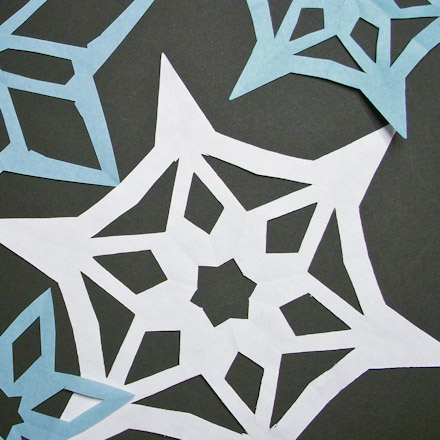
After you complete this project, you will be able to make a snowflake from any square sheet of paper with easy folds and a few cuts. You will learn how to make snowflakes by using the simple snowflake and plain square patterns first.
Once you understand how to make a paper snowflake, get creative! Make snowflakes of your own design with white paper, colored paper, wrapping paper, origami paper, or just about any lightweight paper. Put your snowflakes in the window. Hang them from string in a doorway. Use them as ornaments at Christmas. What are your ideas?
Snowflakes, like many things in nature, are symmetrical. Something is said to have symmetry when its different parts match in size, shape, and position. When you make these paper snowflakes, you'll notice that the symmetry of snowflakes is six-sided, or in six parts. At the end of this project page, you can learn more about snowflakes and symmetry.
Related craft: See how to make a blizzard of tissue paper snowflakes in the Easy Paper Snowflakes craft project and see how to decorate windows with snowflakes in the Snowflake Window Stencils craft project.
Choose the size snowflake that you want to make. It's a good idea to choose one of the simple snowflake patterns first. They include squares with fold lines and a cutting pattern. After that, use one of the folding patterns with a cutting pattern or with your own design. If you don't need the fold lines, just use a square sheet of paper. Download the pattern for the snowflake and print it on white computer paper. Print cutting patterns on cardstock. The cutting patterns are in three sizes for 3½", 6" and 8" squares of paper.
There are also cutting patterns for some of Aunt Annie's favorite snowflakes, including hearts for Valentine's Day! Some of these patterns are more detailed and harder to cut, but they are worth the effort!
Patterns are Adobe PDF files. The Adobe Reader is available for free.
All of Aunt Annie's project patterns are designed to be printed on standard letter size paper (8.5"x11" or A4). When printing from Adobe Reader, you may need to select "Auto-Rotate and Center" or "Choose paper source by PDF page size" to ensure the best fit.
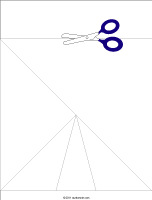
Cut on the square outline. Try to make your cuts very straight, and the corners square.
All paper snowflakes start with a square sheet of paper. The large snowflakes in this project use an 8" (20 cm) square; the medium ones are based on a 6" (15 cm) square, and the small ones on a 3½" (9 cm) square. If you don't need the fold lines, just cut a square of the right size to use with one of the cutting patterns. If you plan to make a snowflake of your own design, any size square will work fine.
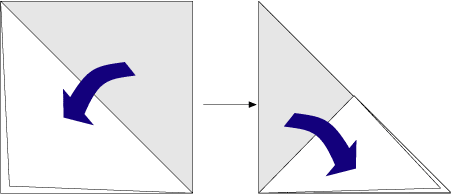
Fold the square in half on the diagonal, and then fold it in half again on the other diagonal.
Keep the fold marks on the outside of the fold.
After these two folds, you will have a right isosceles triangle. That is, one angle of the triangle is 90° (right), and two to its sides are equal in length.

With the right angle pointing up, fold the triangle in thirds. Fold one side over, then fold the other side over on top of it. Keep the fold marks on the outside of the fold.
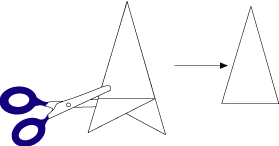
Trim the corners off to make a triangle. If you open the folded paper now, you'll have a twelve-sided polygon.

Skip this step if you are making one of the simple snowflakes.
With a pencil, draw a pattern for your snowflake on the folded triangle. You can either cut out and trace one of the cutting patterns from this project, or make a design of your own.
The center of the snowflake is the point of the triangle (smallest angle). The points of the snowflake are the other two corners. Cut off one of the corners to make a six pointed snowflake.

Cut on the pattern lines. Be sure to cut straight. Erase any pencil line marks remaining. Now carefully unfold the paper to see the beautiful snowflake you made.
Kids, if you have trouble making the cuts, ask an adult for help. You may need a sharper pair of scissors.
More fun: Run by a CalTech professor, SnowCrystals.com contains pictures of actual frozen snowflakes under magnification, information on the physics of snowflakes and activities such as how to make and photograph your own snowflakes!
Where will you display your
snowflakes?
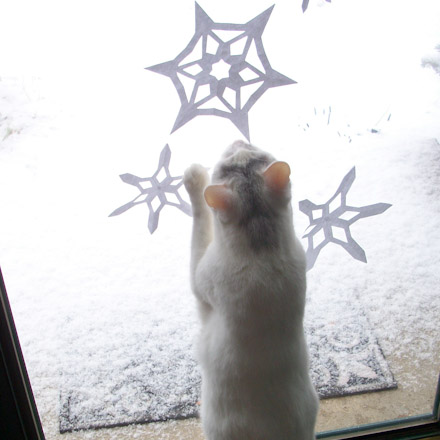
Snowflakes, like many things in nature, are symmetrical. Something is said to have symmetry when its different parts match in size, shape, and position. In nature, there are two primary types of symmetry—bilateral symmetry and radial symmetry.
In bilateral symmetry, two halves are mirror images of each other. Many things in nature have bilateral symmetry: for example, leaves, butterflies, cats, dogs, and people. Look at yourself in the mirror. Do the right and left sides of your face appear to be the same?
Snowflakes have radial symmetry, meaning that they are symmetrical around their centers. Other things that have radial symmetry are many flowers, bicycle wheels, pumpkins, and oranges. What other things fit in this category?
Snowflakes are ice crystals that form in hexagonal shapes. This means that the symmetry of snowflakes is six-sided, or in six parts. Cut a snowflake into six parts, and each part will be the same as the other five. To make our paper snowflakes, we fold the paper into six pie-shaped pieces. When all the pieces are cut together, we get six identical parts that unfold into a hexagonally-shaped snowflake.